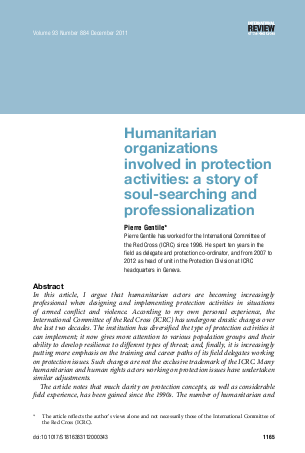
In this article, I argue that humanitarian actors are becoming increasingly professional when designing and implementing protection activities in situations of armed conflict and violence. According to my own personal experience, the International Committee of the Red Cross (ICRC) has undergone drastic changes over the last two decades. The institution has diversified the type of protection activities it can implement; it now gives more attention to various population groups and their ability to develop resilience to different types of threat; and, finally, it is increasingly putting more emphasis on the training and career paths of its field delegates working on protection issues. Such changes are not the exclusive trademark of the ICRC. Many humanitarian and human rights actors working on protection issues have undertaken similar adjustments. The article notes that much clarity on protection concepts, as well as considerable field experience, has been gained since the 1990s. The number of humanitarian and human rights organizations implementing protection activities in the field has steadily increased. Positive as well as negative lessons learned have been documented and have helped to shape institutional guidance and guidelines. Inter-institutional exchanges have strengthened, allowing the development of professional standards for protection work, to ensure that protection work is as safe and efficient as possible. In the end, this professionalization of the field of protection is in the best interests of both the communities affected by violence and disasters, and the humanitarian field workers confronted by complex challenges.
Resource collections
- UN Habitat - Urban Response Collection
- Urban Response - Urban Crisis Preparedness and Risk Reduction
- Urban Response Collection - Community Engagement and Social Cohesion
- Urban Response Collection - Economic Recovery
- Urban Response Collection - Environment and Climate Change
- Urban Response Collection - Housing, Land and Property
- Urban Response Collection - Urban Crisis Response, Recovery and Reconstruction
- Urban Response Collection - Urban Resilience